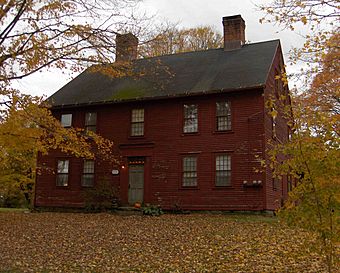White's Tavern facts for kids
Quick facts for kids |
|
|
White's Tavern
|
|
 |
|
| Location | 131 US 6, Andover, Connecticut |
|---|---|
| Area | 3 acres (1.2 ha) |
| Built | 1773 |
| Architectural style | Colonial |
| NRHP reference No. | 91000947 |
| Added to NRHP | July 26, 1991 |
White's Tavern, also known as the Daniel White Tavern, is a very old building in Andover, Connecticut. It was built in 1773 and used to be a busy inn where travelers could stay. This building is special because it shows us what colonial-era buildings looked like. It's also famous for hosting French officers during the American Revolutionary War. Today, White's Tavern is a private home. It was added to the National Register of Historic Places in 1991, which means it's an important historical site.
About White's Tavern
White's Tavern is located on the east side of US Route 6. It sits between US 6 and Hutchinson Road. Hutchinson Road was once a main road back in the 1700s. Even though its address is on US 6 now, the building actually faces east toward Hutchinson Road.
Building Design and Features
The tavern is a large, two-and-a-half-story building made of wood. It has five sections across the front and two chimneys inside. The windows are placed closer together than you might expect, making the middle part of the building look a bit narrower. The main door has simple decorations around it and a small window above it.
Inside, the building has a central hallway. Many of the original wide wooden floorboards are still there. You can also see the old plaster walls and fireplaces. Some rooms upstairs have special "swinging walls." These walls are on hinges and can be moved to open up a very large space, perfect for a ballroom or big gatherings.
A Place in History
Daniel White built this tavern in 1773. It was a working tavern when the French Army marched through the area in 1781. The French soldiers were helping America fight for independence during the Revolutionary War. They even camped just north of the tavern.
Important French officers stayed at White's Tavern. One of them was the Marquis de Chastellux. He was a French general and writer. The building is also important because it is a very well-preserved example of an 18th-century tavern house. It helps us understand what life was like back then.
Images for kids




